Unit 44: Control and Integration of Renewable Energy Sources - Report
VerifiedAdded on 2023/01/19
|13
|3928
|99
Report
AI Summary
This report provides a comprehensive analysis of renewable energy sources, focusing on their environmental impact, effectiveness, and cost-efficiency. It begins by differentiating between primary and renewable energy sources, highlighting the benefits of renewables like solar, wind, geothermal, a...
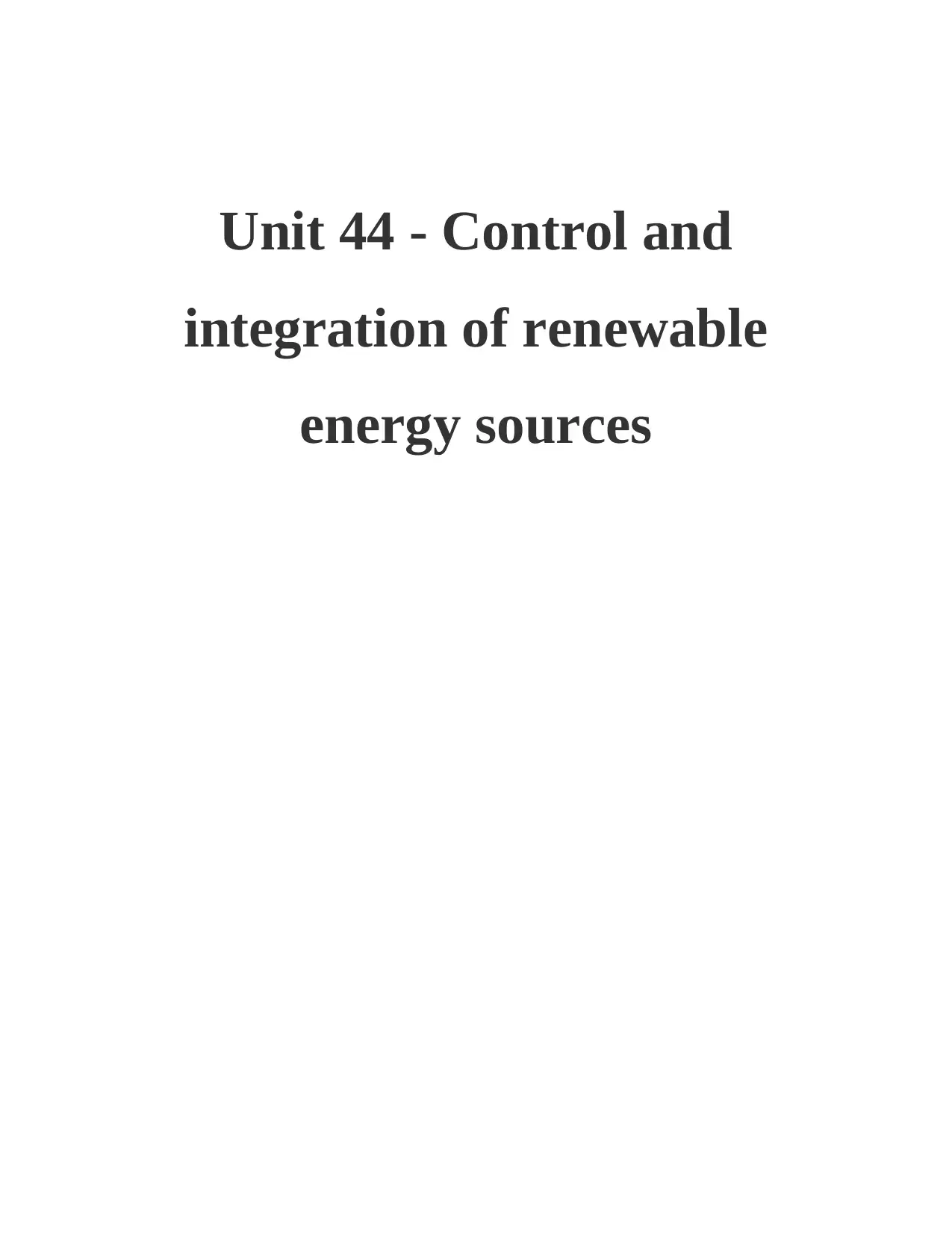
Unit 44 - Control and
integration of renewable
energy sources
integration of renewable
energy sources
Paraphrase This Document
Need a fresh take? Get an instant paraphrase of this document with our AI Paraphraser
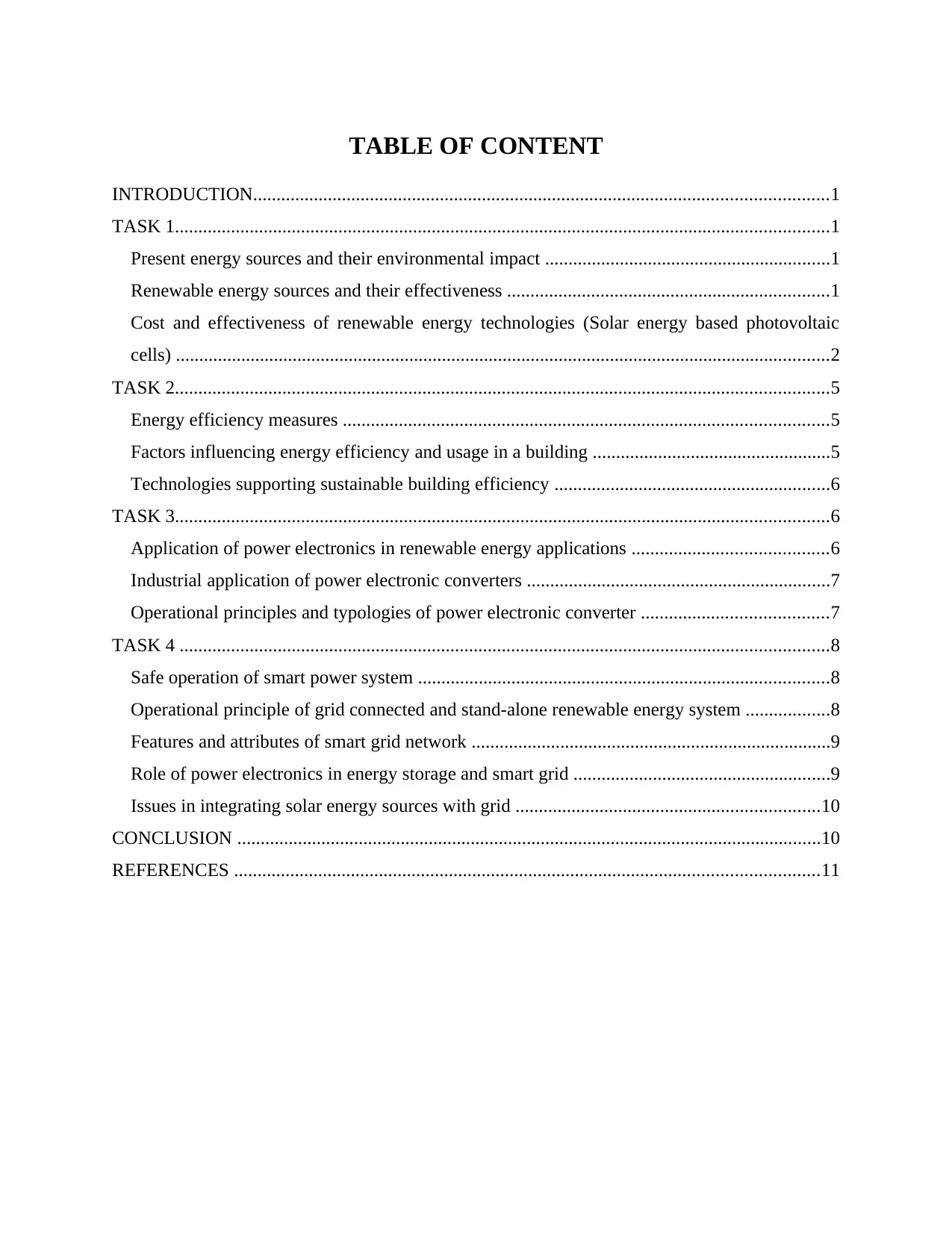
TABLE OF CONTENT
INTRODUCTION...........................................................................................................................1
TASK 1............................................................................................................................................1
Present energy sources and their environmental impact .............................................................1
Renewable energy sources and their effectiveness .....................................................................1
Cost and effectiveness of renewable energy technologies (Solar energy based photovoltaic
cells) ............................................................................................................................................2
TASK 2............................................................................................................................................5
Energy efficiency measures ........................................................................................................5
Factors influencing energy efficiency and usage in a building ...................................................5
Technologies supporting sustainable building efficiency ...........................................................6
TASK 3............................................................................................................................................6
Application of power electronics in renewable energy applications ..........................................6
Industrial application of power electronic converters .................................................................7
Operational principles and typologies of power electronic converter ........................................7
TASK 4 ...........................................................................................................................................8
Safe operation of smart power system ........................................................................................8
Operational principle of grid connected and stand-alone renewable energy system ..................8
Features and attributes of smart grid network .............................................................................9
Role of power electronics in energy storage and smart grid .......................................................9
Issues in integrating solar energy sources with grid .................................................................10
CONCLUSION .............................................................................................................................10
REFERENCES .............................................................................................................................11
INTRODUCTION...........................................................................................................................1
TASK 1............................................................................................................................................1
Present energy sources and their environmental impact .............................................................1
Renewable energy sources and their effectiveness .....................................................................1
Cost and effectiveness of renewable energy technologies (Solar energy based photovoltaic
cells) ............................................................................................................................................2
TASK 2............................................................................................................................................5
Energy efficiency measures ........................................................................................................5
Factors influencing energy efficiency and usage in a building ...................................................5
Technologies supporting sustainable building efficiency ...........................................................6
TASK 3............................................................................................................................................6
Application of power electronics in renewable energy applications ..........................................6
Industrial application of power electronic converters .................................................................7
Operational principles and typologies of power electronic converter ........................................7
TASK 4 ...........................................................................................................................................8
Safe operation of smart power system ........................................................................................8
Operational principle of grid connected and stand-alone renewable energy system ..................8
Features and attributes of smart grid network .............................................................................9
Role of power electronics in energy storage and smart grid .......................................................9
Issues in integrating solar energy sources with grid .................................................................10
CONCLUSION .............................................................................................................................10
REFERENCES .............................................................................................................................11
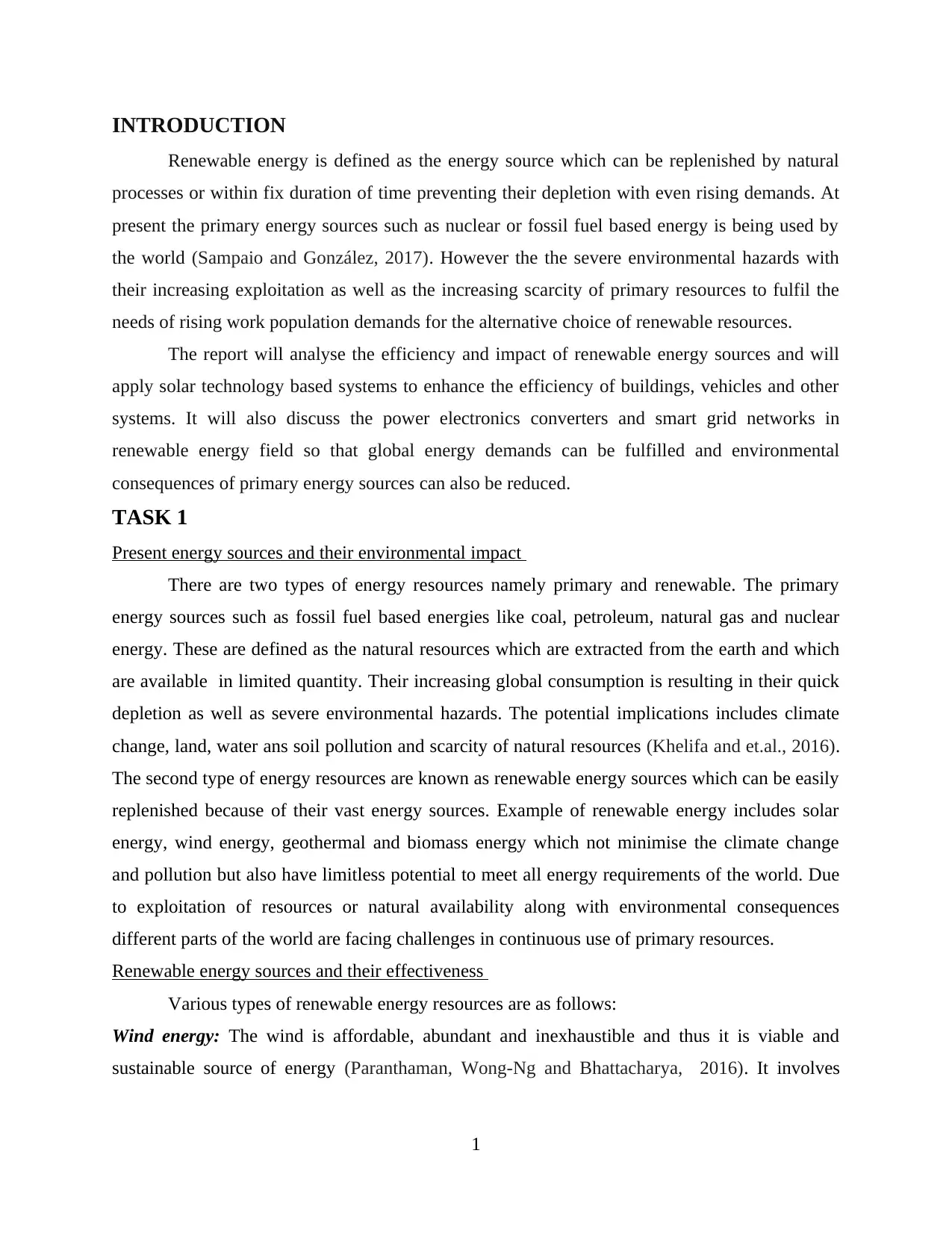
INTRODUCTION
Renewable energy is defined as the energy source which can be replenished by natural
processes or within fix duration of time preventing their depletion with even rising demands. At
present the primary energy sources such as nuclear or fossil fuel based energy is being used by
the world (Sampaio and González, 2017). However the the severe environmental hazards with
their increasing exploitation as well as the increasing scarcity of primary resources to fulfil the
needs of rising work population demands for the alternative choice of renewable resources.
The report will analyse the efficiency and impact of renewable energy sources and will
apply solar technology based systems to enhance the efficiency of buildings, vehicles and other
systems. It will also discuss the power electronics converters and smart grid networks in
renewable energy field so that global energy demands can be fulfilled and environmental
consequences of primary energy sources can also be reduced.
TASK 1
Present energy sources and their environmental impact
There are two types of energy resources namely primary and renewable. The primary
energy sources such as fossil fuel based energies like coal, petroleum, natural gas and nuclear
energy. These are defined as the natural resources which are extracted from the earth and which
are available in limited quantity. Their increasing global consumption is resulting in their quick
depletion as well as severe environmental hazards. The potential implications includes climate
change, land, water ans soil pollution and scarcity of natural resources (Khelifa and et.al., 2016).
The second type of energy resources are known as renewable energy sources which can be easily
replenished because of their vast energy sources. Example of renewable energy includes solar
energy, wind energy, geothermal and biomass energy which not minimise the climate change
and pollution but also have limitless potential to meet all energy requirements of the world. Due
to exploitation of resources or natural availability along with environmental consequences
different parts of the world are facing challenges in continuous use of primary resources.
Renewable energy sources and their effectiveness
Various types of renewable energy resources are as follows:
Wind energy: The wind is affordable, abundant and inexhaustible and thus it is viable and
sustainable source of energy (Paranthaman, Wong-Ng and Bhattacharya, 2016). It involves
1
Renewable energy is defined as the energy source which can be replenished by natural
processes or within fix duration of time preventing their depletion with even rising demands. At
present the primary energy sources such as nuclear or fossil fuel based energy is being used by
the world (Sampaio and González, 2017). However the the severe environmental hazards with
their increasing exploitation as well as the increasing scarcity of primary resources to fulfil the
needs of rising work population demands for the alternative choice of renewable resources.
The report will analyse the efficiency and impact of renewable energy sources and will
apply solar technology based systems to enhance the efficiency of buildings, vehicles and other
systems. It will also discuss the power electronics converters and smart grid networks in
renewable energy field so that global energy demands can be fulfilled and environmental
consequences of primary energy sources can also be reduced.
TASK 1
Present energy sources and their environmental impact
There are two types of energy resources namely primary and renewable. The primary
energy sources such as fossil fuel based energies like coal, petroleum, natural gas and nuclear
energy. These are defined as the natural resources which are extracted from the earth and which
are available in limited quantity. Their increasing global consumption is resulting in their quick
depletion as well as severe environmental hazards. The potential implications includes climate
change, land, water ans soil pollution and scarcity of natural resources (Khelifa and et.al., 2016).
The second type of energy resources are known as renewable energy sources which can be easily
replenished because of their vast energy sources. Example of renewable energy includes solar
energy, wind energy, geothermal and biomass energy which not minimise the climate change
and pollution but also have limitless potential to meet all energy requirements of the world. Due
to exploitation of resources or natural availability along with environmental consequences
different parts of the world are facing challenges in continuous use of primary resources.
Renewable energy sources and their effectiveness
Various types of renewable energy resources are as follows:
Wind energy: The wind is affordable, abundant and inexhaustible and thus it is viable and
sustainable source of energy (Paranthaman, Wong-Ng and Bhattacharya, 2016). It involves
1
⊘ This is a preview!⊘
Do you want full access?
Subscribe today to unlock all pages.

Trusted by 1+ million students worldwide
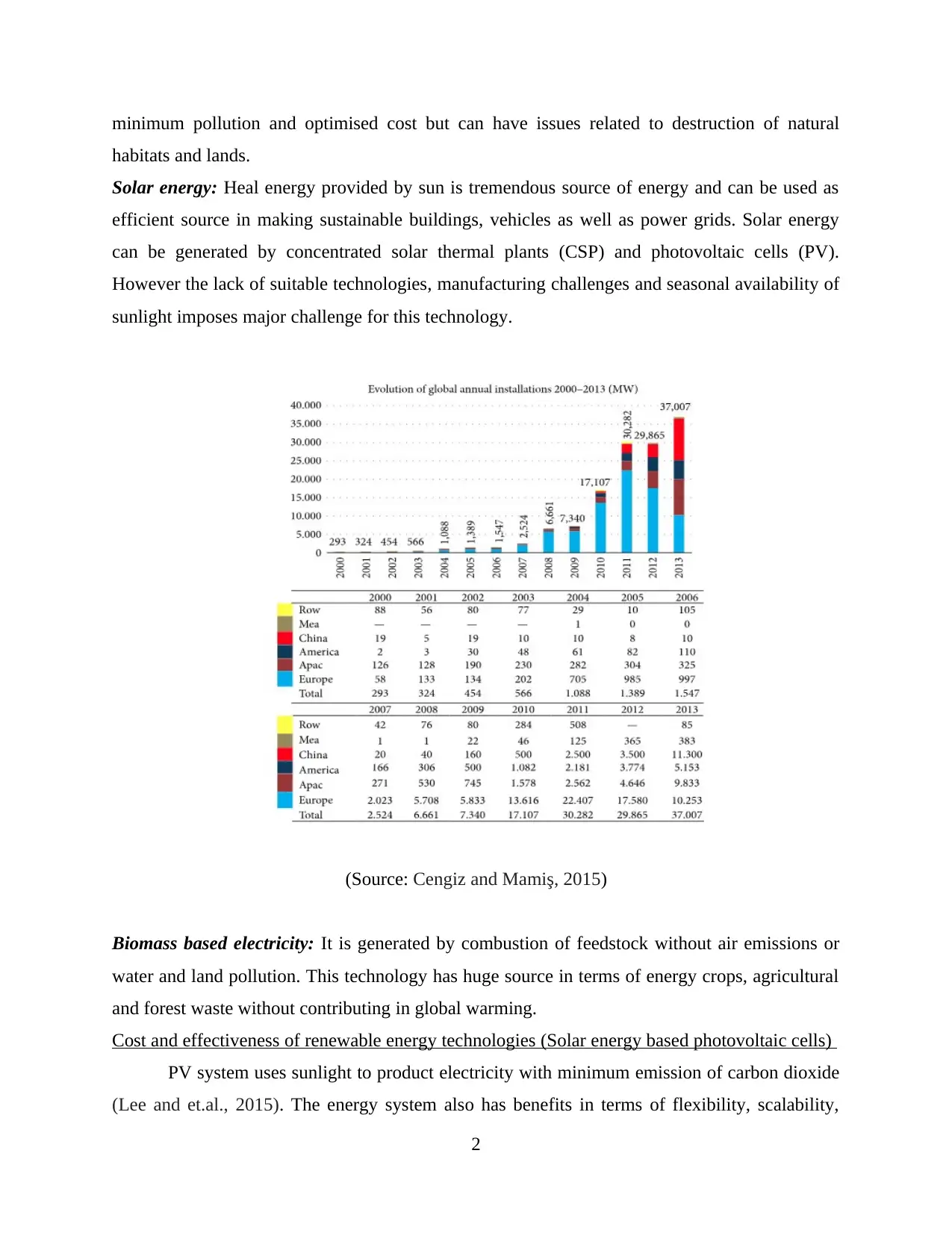
minimum pollution and optimised cost but can have issues related to destruction of natural
habitats and lands.
Solar energy: Heal energy provided by sun is tremendous source of energy and can be used as
efficient source in making sustainable buildings, vehicles as well as power grids. Solar energy
can be generated by concentrated solar thermal plants (CSP) and photovoltaic cells (PV).
However the lack of suitable technologies, manufacturing challenges and seasonal availability of
sunlight imposes major challenge for this technology.
(Source: Cengiz and Mamiş, 2015)
Biomass based electricity: It is generated by combustion of feedstock without air emissions or
water and land pollution. This technology has huge source in terms of energy crops, agricultural
and forest waste without contributing in global warming.
Cost and effectiveness of renewable energy technologies (Solar energy based photovoltaic cells)
PV system uses sunlight to product electricity with minimum emission of carbon dioxide
(Lee and et.al., 2015). The energy system also has benefits in terms of flexibility, scalability,
2
habitats and lands.
Solar energy: Heal energy provided by sun is tremendous source of energy and can be used as
efficient source in making sustainable buildings, vehicles as well as power grids. Solar energy
can be generated by concentrated solar thermal plants (CSP) and photovoltaic cells (PV).
However the lack of suitable technologies, manufacturing challenges and seasonal availability of
sunlight imposes major challenge for this technology.
(Source: Cengiz and Mamiş, 2015)
Biomass based electricity: It is generated by combustion of feedstock without air emissions or
water and land pollution. This technology has huge source in terms of energy crops, agricultural
and forest waste without contributing in global warming.
Cost and effectiveness of renewable energy technologies (Solar energy based photovoltaic cells)
PV system uses sunlight to product electricity with minimum emission of carbon dioxide
(Lee and et.al., 2015). The energy system also has benefits in terms of flexibility, scalability,
2
Paraphrase This Document
Need a fresh take? Get an instant paraphrase of this document with our AI Paraphraser
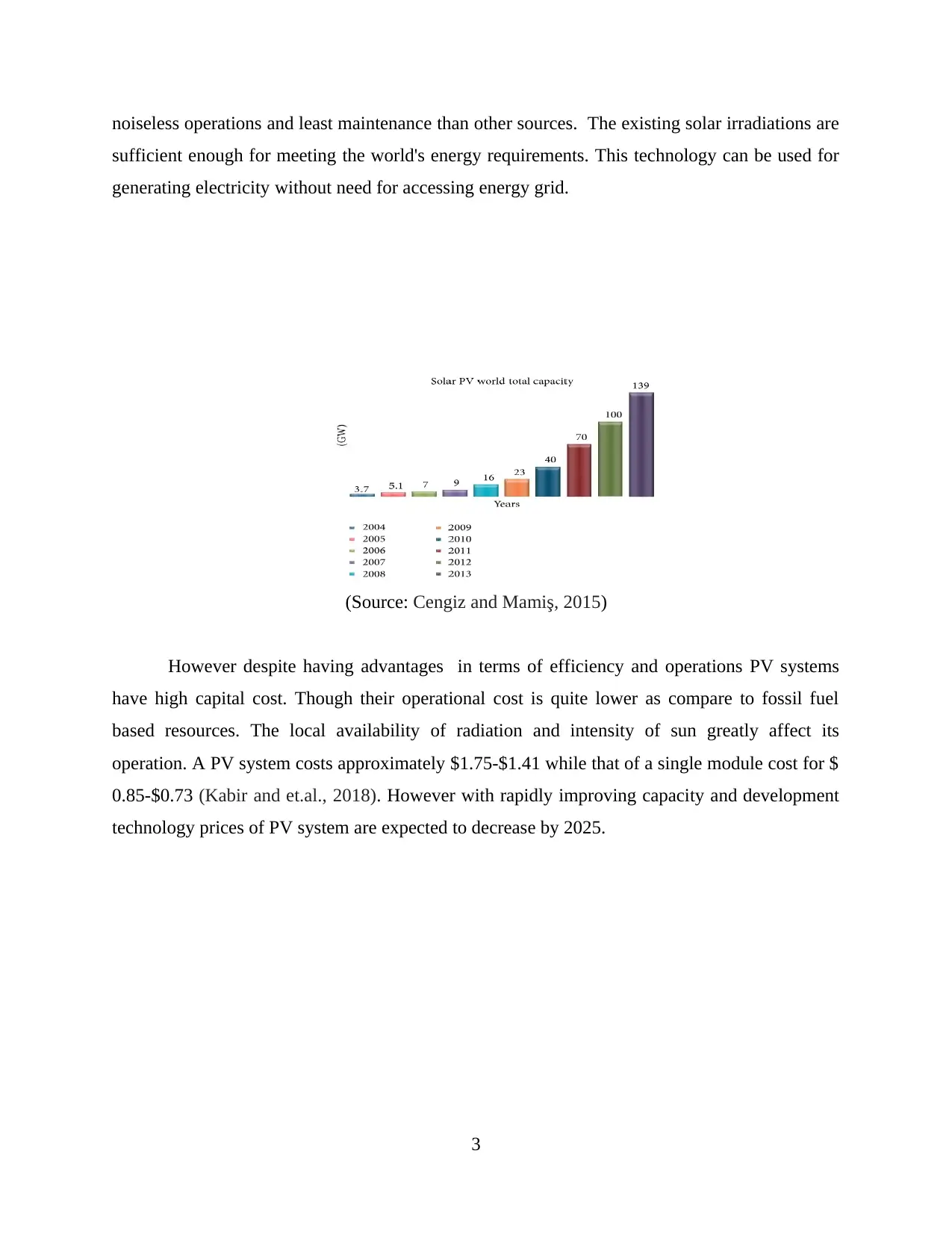
noiseless operations and least maintenance than other sources. The existing solar irradiations are
sufficient enough for meeting the world's energy requirements. This technology can be used for
generating electricity without need for accessing energy grid.
(Source: Cengiz and Mamiş, 2015)
However despite having advantages in terms of efficiency and operations PV systems
have high capital cost. Though their operational cost is quite lower as compare to fossil fuel
based resources. The local availability of radiation and intensity of sun greatly affect its
operation. A PV system costs approximately $1.75-$1.41 while that of a single module cost for $
0.85-$0.73 (Kabir and et.al., 2018). However with rapidly improving capacity and development
technology prices of PV system are expected to decrease by 2025.
3
sufficient enough for meeting the world's energy requirements. This technology can be used for
generating electricity without need for accessing energy grid.
(Source: Cengiz and Mamiş, 2015)
However despite having advantages in terms of efficiency and operations PV systems
have high capital cost. Though their operational cost is quite lower as compare to fossil fuel
based resources. The local availability of radiation and intensity of sun greatly affect its
operation. A PV system costs approximately $1.75-$1.41 while that of a single module cost for $
0.85-$0.73 (Kabir and et.al., 2018). However with rapidly improving capacity and development
technology prices of PV system are expected to decrease by 2025.
3
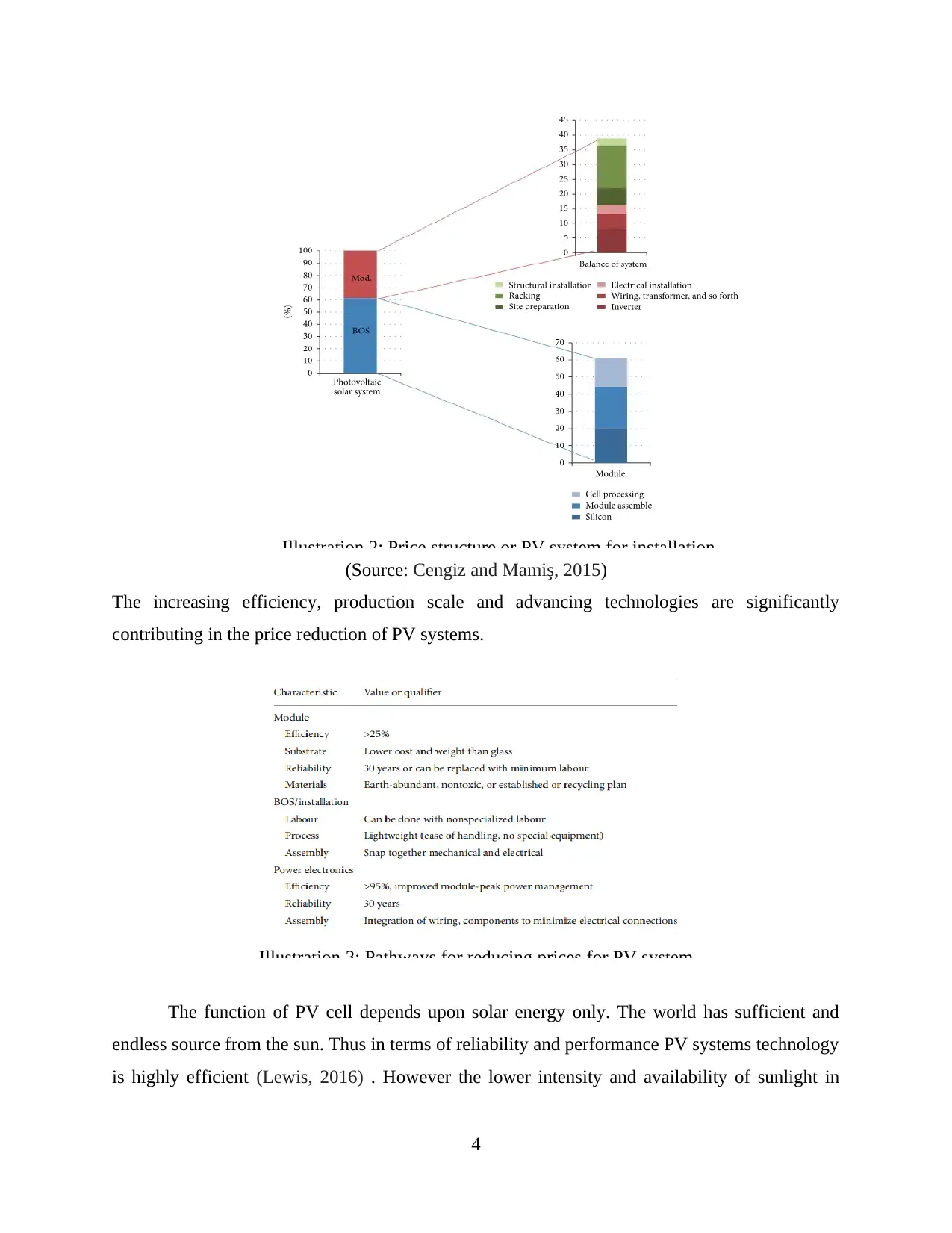
(Source: Cengiz and Mamiş, 2015)
The increasing efficiency, production scale and advancing technologies are significantly
contributing in the price reduction of PV systems.
The function of PV cell depends upon solar energy only. The world has sufficient and
endless source from the sun. Thus in terms of reliability and performance PV systems technology
is highly efficient (Lewis, 2016) . However the lower intensity and availability of sunlight in
4
Illustration 2: Price structure or PV system for installation
Illustration 3: Pathways for reducing prices for PV system
The increasing efficiency, production scale and advancing technologies are significantly
contributing in the price reduction of PV systems.
The function of PV cell depends upon solar energy only. The world has sufficient and
endless source from the sun. Thus in terms of reliability and performance PV systems technology
is highly efficient (Lewis, 2016) . However the lower intensity and availability of sunlight in
4
Illustration 2: Price structure or PV system for installation
Illustration 3: Pathways for reducing prices for PV system
⊘ This is a preview!⊘
Do you want full access?
Subscribe today to unlock all pages.

Trusted by 1+ million students worldwide
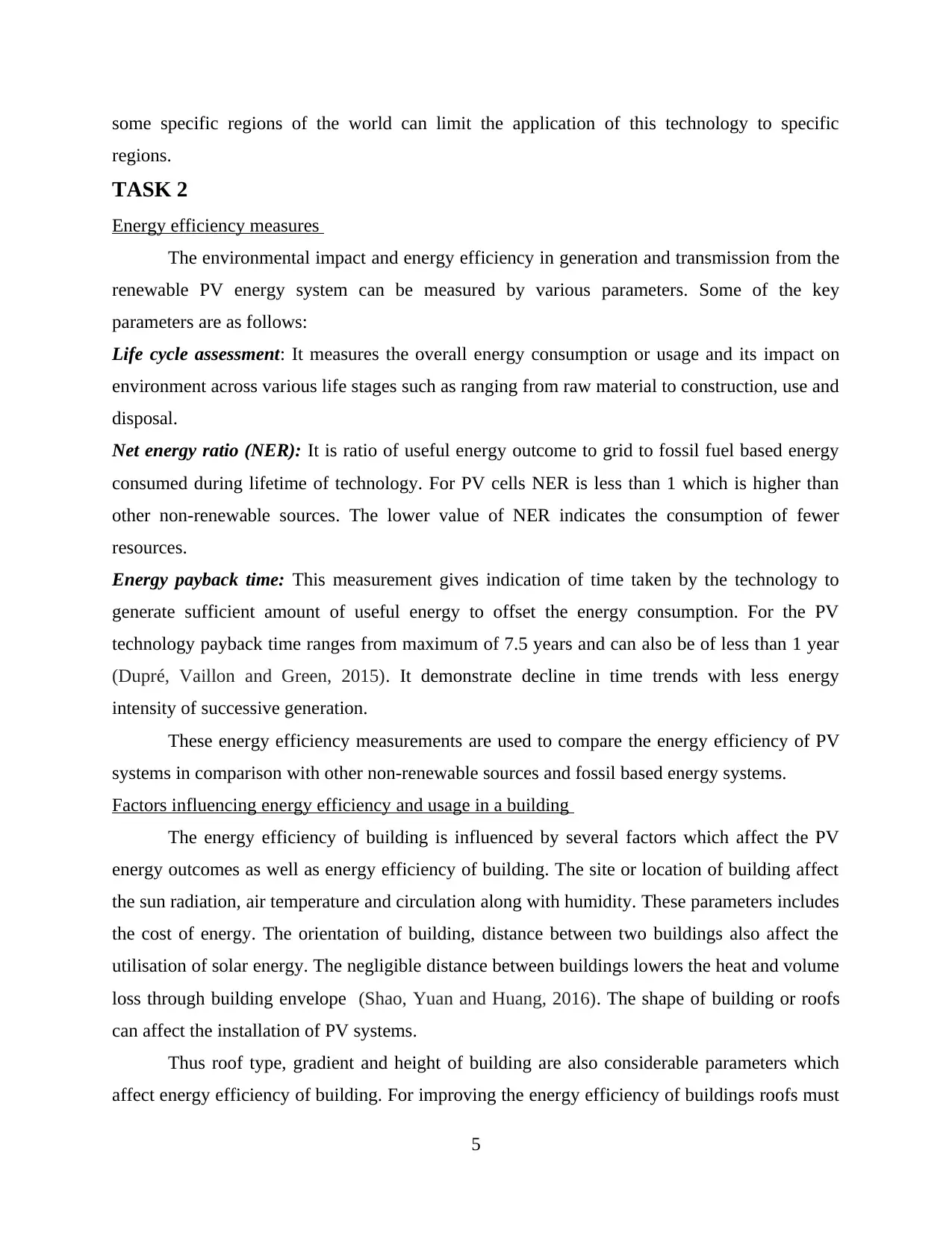
some specific regions of the world can limit the application of this technology to specific
regions.
TASK 2
Energy efficiency measures
The environmental impact and energy efficiency in generation and transmission from the
renewable PV energy system can be measured by various parameters. Some of the key
parameters are as follows:
Life cycle assessment: It measures the overall energy consumption or usage and its impact on
environment across various life stages such as ranging from raw material to construction, use and
disposal.
Net energy ratio (NER): It is ratio of useful energy outcome to grid to fossil fuel based energy
consumed during lifetime of technology. For PV cells NER is less than 1 which is higher than
other non-renewable sources. The lower value of NER indicates the consumption of fewer
resources.
Energy payback time: This measurement gives indication of time taken by the technology to
generate sufficient amount of useful energy to offset the energy consumption. For the PV
technology payback time ranges from maximum of 7.5 years and can also be of less than 1 year
(Dupré, Vaillon and Green, 2015). It demonstrate decline in time trends with less energy
intensity of successive generation.
These energy efficiency measurements are used to compare the energy efficiency of PV
systems in comparison with other non-renewable sources and fossil based energy systems.
Factors influencing energy efficiency and usage in a building
The energy efficiency of building is influenced by several factors which affect the PV
energy outcomes as well as energy efficiency of building. The site or location of building affect
the sun radiation, air temperature and circulation along with humidity. These parameters includes
the cost of energy. The orientation of building, distance between two buildings also affect the
utilisation of solar energy. The negligible distance between buildings lowers the heat and volume
loss through building envelope (Shao, Yuan and Huang, 2016). The shape of building or roofs
can affect the installation of PV systems.
Thus roof type, gradient and height of building are also considerable parameters which
affect energy efficiency of building. For improving the energy efficiency of buildings roofs must
5
regions.
TASK 2
Energy efficiency measures
The environmental impact and energy efficiency in generation and transmission from the
renewable PV energy system can be measured by various parameters. Some of the key
parameters are as follows:
Life cycle assessment: It measures the overall energy consumption or usage and its impact on
environment across various life stages such as ranging from raw material to construction, use and
disposal.
Net energy ratio (NER): It is ratio of useful energy outcome to grid to fossil fuel based energy
consumed during lifetime of technology. For PV cells NER is less than 1 which is higher than
other non-renewable sources. The lower value of NER indicates the consumption of fewer
resources.
Energy payback time: This measurement gives indication of time taken by the technology to
generate sufficient amount of useful energy to offset the energy consumption. For the PV
technology payback time ranges from maximum of 7.5 years and can also be of less than 1 year
(Dupré, Vaillon and Green, 2015). It demonstrate decline in time trends with less energy
intensity of successive generation.
These energy efficiency measurements are used to compare the energy efficiency of PV
systems in comparison with other non-renewable sources and fossil based energy systems.
Factors influencing energy efficiency and usage in a building
The energy efficiency of building is influenced by several factors which affect the PV
energy outcomes as well as energy efficiency of building. The site or location of building affect
the sun radiation, air temperature and circulation along with humidity. These parameters includes
the cost of energy. The orientation of building, distance between two buildings also affect the
utilisation of solar energy. The negligible distance between buildings lowers the heat and volume
loss through building envelope (Shao, Yuan and Huang, 2016). The shape of building or roofs
can affect the installation of PV systems.
Thus roof type, gradient and height of building are also considerable parameters which
affect energy efficiency of building. For improving the energy efficiency of buildings roofs must
5
Paraphrase This Document
Need a fresh take? Get an instant paraphrase of this document with our AI Paraphraser
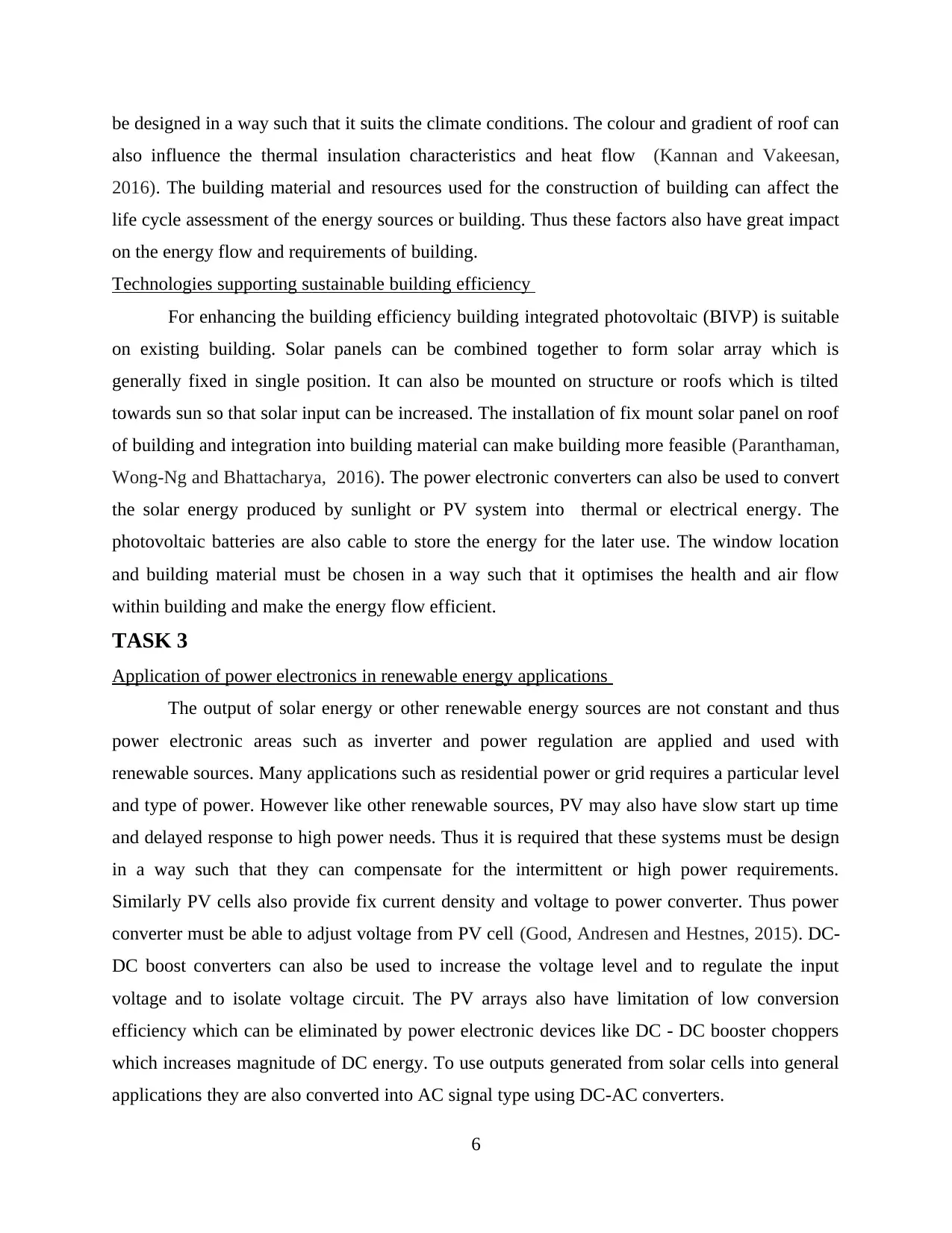
be designed in a way such that it suits the climate conditions. The colour and gradient of roof can
also influence the thermal insulation characteristics and heat flow (Kannan and Vakeesan,
2016). The building material and resources used for the construction of building can affect the
life cycle assessment of the energy sources or building. Thus these factors also have great impact
on the energy flow and requirements of building.
Technologies supporting sustainable building efficiency
For enhancing the building efficiency building integrated photovoltaic (BIVP) is suitable
on existing building. Solar panels can be combined together to form solar array which is
generally fixed in single position. It can also be mounted on structure or roofs which is tilted
towards sun so that solar input can be increased. The installation of fix mount solar panel on roof
of building and integration into building material can make building more feasible (Paranthaman,
Wong-Ng and Bhattacharya, 2016). The power electronic converters can also be used to convert
the solar energy produced by sunlight or PV system into thermal or electrical energy. The
photovoltaic batteries are also cable to store the energy for the later use. The window location
and building material must be chosen in a way such that it optimises the health and air flow
within building and make the energy flow efficient.
TASK 3
Application of power electronics in renewable energy applications
The output of solar energy or other renewable energy sources are not constant and thus
power electronic areas such as inverter and power regulation are applied and used with
renewable sources. Many applications such as residential power or grid requires a particular level
and type of power. However like other renewable sources, PV may also have slow start up time
and delayed response to high power needs. Thus it is required that these systems must be design
in a way such that they can compensate for the intermittent or high power requirements.
Similarly PV cells also provide fix current density and voltage to power converter. Thus power
converter must be able to adjust voltage from PV cell (Good, Andresen and Hestnes, 2015). DC-
DC boost converters can also be used to increase the voltage level and to regulate the input
voltage and to isolate voltage circuit. The PV arrays also have limitation of low conversion
efficiency which can be eliminated by power electronic devices like DC - DC booster choppers
which increases magnitude of DC energy. To use outputs generated from solar cells into general
applications they are also converted into AC signal type using DC-AC converters.
6
also influence the thermal insulation characteristics and heat flow (Kannan and Vakeesan,
2016). The building material and resources used for the construction of building can affect the
life cycle assessment of the energy sources or building. Thus these factors also have great impact
on the energy flow and requirements of building.
Technologies supporting sustainable building efficiency
For enhancing the building efficiency building integrated photovoltaic (BIVP) is suitable
on existing building. Solar panels can be combined together to form solar array which is
generally fixed in single position. It can also be mounted on structure or roofs which is tilted
towards sun so that solar input can be increased. The installation of fix mount solar panel on roof
of building and integration into building material can make building more feasible (Paranthaman,
Wong-Ng and Bhattacharya, 2016). The power electronic converters can also be used to convert
the solar energy produced by sunlight or PV system into thermal or electrical energy. The
photovoltaic batteries are also cable to store the energy for the later use. The window location
and building material must be chosen in a way such that it optimises the health and air flow
within building and make the energy flow efficient.
TASK 3
Application of power electronics in renewable energy applications
The output of solar energy or other renewable energy sources are not constant and thus
power electronic areas such as inverter and power regulation are applied and used with
renewable sources. Many applications such as residential power or grid requires a particular level
and type of power. However like other renewable sources, PV may also have slow start up time
and delayed response to high power needs. Thus it is required that these systems must be design
in a way such that they can compensate for the intermittent or high power requirements.
Similarly PV cells also provide fix current density and voltage to power converter. Thus power
converter must be able to adjust voltage from PV cell (Good, Andresen and Hestnes, 2015). DC-
DC boost converters can also be used to increase the voltage level and to regulate the input
voltage and to isolate voltage circuit. The PV arrays also have limitation of low conversion
efficiency which can be eliminated by power electronic devices like DC - DC booster choppers
which increases magnitude of DC energy. To use outputs generated from solar cells into general
applications they are also converted into AC signal type using DC-AC converters.
6
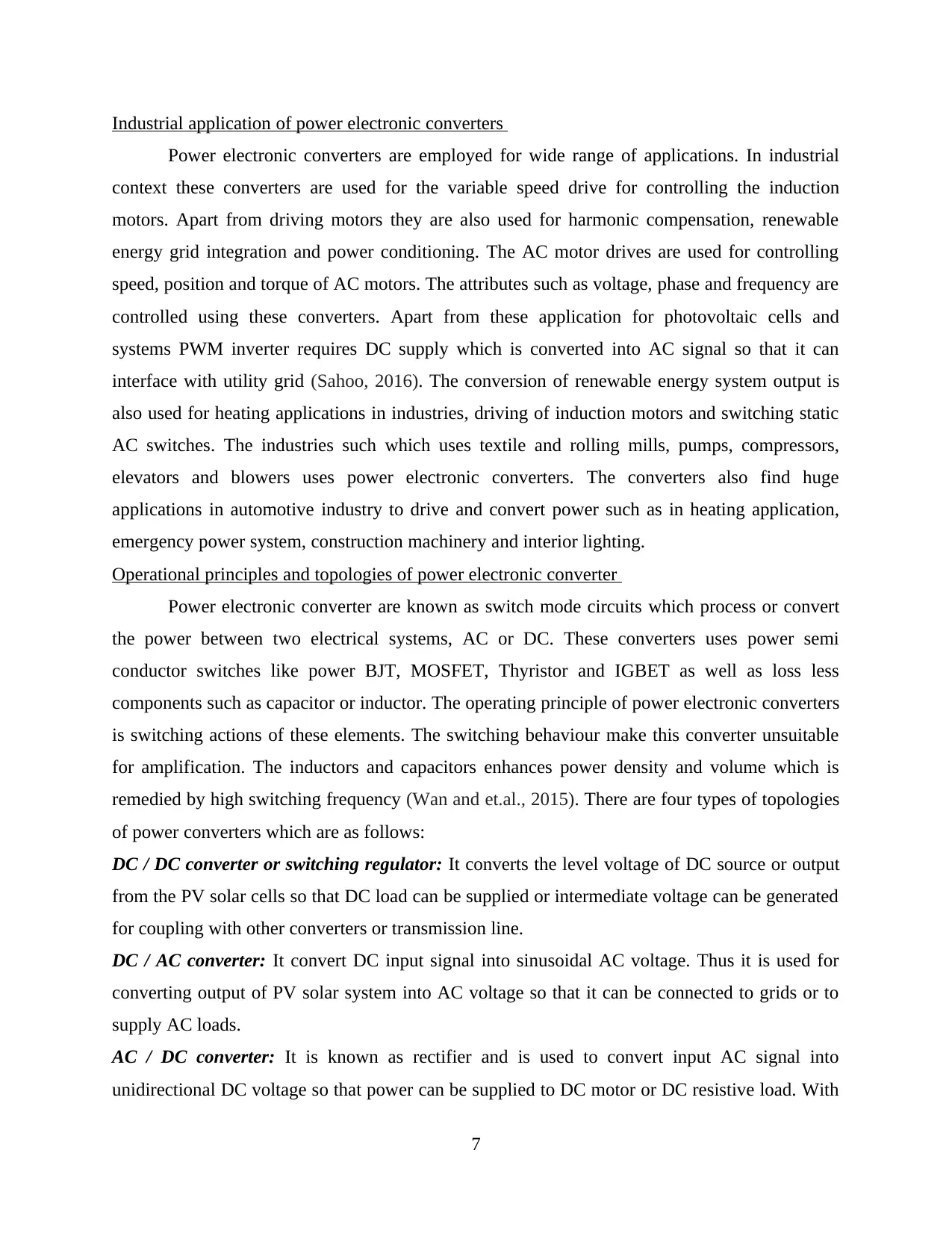
Industrial application of power electronic converters
Power electronic converters are employed for wide range of applications. In industrial
context these converters are used for the variable speed drive for controlling the induction
motors. Apart from driving motors they are also used for harmonic compensation, renewable
energy grid integration and power conditioning. The AC motor drives are used for controlling
speed, position and torque of AC motors. The attributes such as voltage, phase and frequency are
controlled using these converters. Apart from these application for photovoltaic cells and
systems PWM inverter requires DC supply which is converted into AC signal so that it can
interface with utility grid (Sahoo, 2016). The conversion of renewable energy system output is
also used for heating applications in industries, driving of induction motors and switching static
AC switches. The industries such which uses textile and rolling mills, pumps, compressors,
elevators and blowers uses power electronic converters. The converters also find huge
applications in automotive industry to drive and convert power such as in heating application,
emergency power system, construction machinery and interior lighting.
Operational principles and topologies of power electronic converter
Power electronic converter are known as switch mode circuits which process or convert
the power between two electrical systems, AC or DC. These converters uses power semi
conductor switches like power BJT, MOSFET, Thyristor and IGBET as well as loss less
components such as capacitor or inductor. The operating principle of power electronic converters
is switching actions of these elements. The switching behaviour make this converter unsuitable
for amplification. The inductors and capacitors enhances power density and volume which is
remedied by high switching frequency (Wan and et.al., 2015). There are four types of topologies
of power converters which are as follows:
DC / DC converter or switching regulator: It converts the level voltage of DC source or output
from the PV solar cells so that DC load can be supplied or intermediate voltage can be generated
for coupling with other converters or transmission line.
DC / AC converter: It convert DC input signal into sinusoidal AC voltage. Thus it is used for
converting output of PV solar system into AC voltage so that it can be connected to grids or to
supply AC loads.
AC / DC converter: It is known as rectifier and is used to convert input AC signal into
unidirectional DC voltage so that power can be supplied to DC motor or DC resistive load. With
7
Power electronic converters are employed for wide range of applications. In industrial
context these converters are used for the variable speed drive for controlling the induction
motors. Apart from driving motors they are also used for harmonic compensation, renewable
energy grid integration and power conditioning. The AC motor drives are used for controlling
speed, position and torque of AC motors. The attributes such as voltage, phase and frequency are
controlled using these converters. Apart from these application for photovoltaic cells and
systems PWM inverter requires DC supply which is converted into AC signal so that it can
interface with utility grid (Sahoo, 2016). The conversion of renewable energy system output is
also used for heating applications in industries, driving of induction motors and switching static
AC switches. The industries such which uses textile and rolling mills, pumps, compressors,
elevators and blowers uses power electronic converters. The converters also find huge
applications in automotive industry to drive and convert power such as in heating application,
emergency power system, construction machinery and interior lighting.
Operational principles and topologies of power electronic converter
Power electronic converter are known as switch mode circuits which process or convert
the power between two electrical systems, AC or DC. These converters uses power semi
conductor switches like power BJT, MOSFET, Thyristor and IGBET as well as loss less
components such as capacitor or inductor. The operating principle of power electronic converters
is switching actions of these elements. The switching behaviour make this converter unsuitable
for amplification. The inductors and capacitors enhances power density and volume which is
remedied by high switching frequency (Wan and et.al., 2015). There are four types of topologies
of power converters which are as follows:
DC / DC converter or switching regulator: It converts the level voltage of DC source or output
from the PV solar cells so that DC load can be supplied or intermediate voltage can be generated
for coupling with other converters or transmission line.
DC / AC converter: It convert DC input signal into sinusoidal AC voltage. Thus it is used for
converting output of PV solar system into AC voltage so that it can be connected to grids or to
supply AC loads.
AC / DC converter: It is known as rectifier and is used to convert input AC signal into
unidirectional DC voltage so that power can be supplied to DC motor or DC resistive load. With
7
⊘ This is a preview!⊘
Do you want full access?
Subscribe today to unlock all pages.

Trusted by 1+ million students worldwide
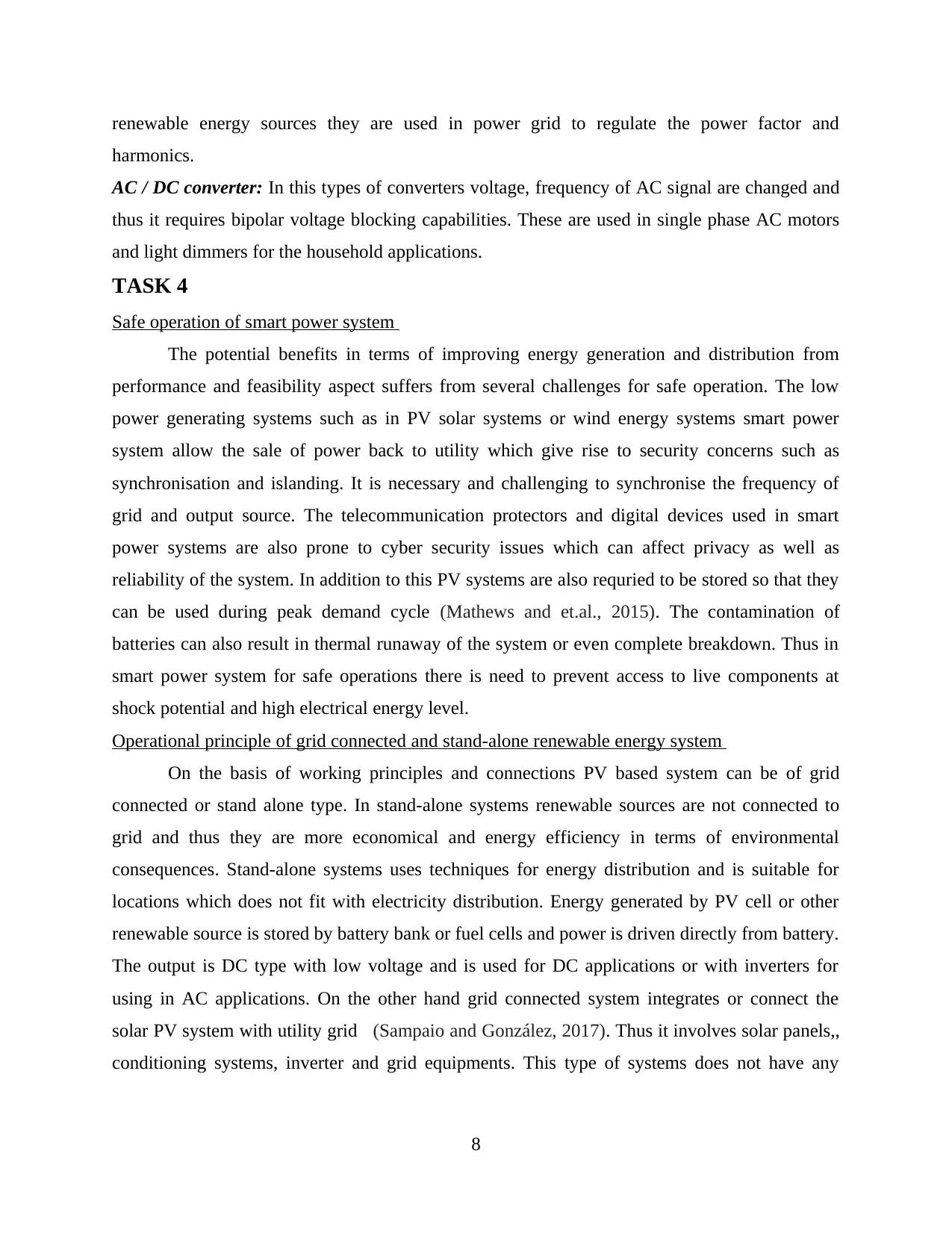
renewable energy sources they are used in power grid to regulate the power factor and
harmonics.
AC / DC converter: In this types of converters voltage, frequency of AC signal are changed and
thus it requires bipolar voltage blocking capabilities. These are used in single phase AC motors
and light dimmers for the household applications.
TASK 4
Safe operation of smart power system
The potential benefits in terms of improving energy generation and distribution from
performance and feasibility aspect suffers from several challenges for safe operation. The low
power generating systems such as in PV solar systems or wind energy systems smart power
system allow the sale of power back to utility which give rise to security concerns such as
synchronisation and islanding. It is necessary and challenging to synchronise the frequency of
grid and output source. The telecommunication protectors and digital devices used in smart
power systems are also prone to cyber security issues which can affect privacy as well as
reliability of the system. In addition to this PV systems are also requried to be stored so that they
can be used during peak demand cycle (Mathews and et.al., 2015). The contamination of
batteries can also result in thermal runaway of the system or even complete breakdown. Thus in
smart power system for safe operations there is need to prevent access to live components at
shock potential and high electrical energy level.
Operational principle of grid connected and stand-alone renewable energy system
On the basis of working principles and connections PV based system can be of grid
connected or stand alone type. In stand-alone systems renewable sources are not connected to
grid and thus they are more economical and energy efficiency in terms of environmental
consequences. Stand-alone systems uses techniques for energy distribution and is suitable for
locations which does not fit with electricity distribution. Energy generated by PV cell or other
renewable source is stored by battery bank or fuel cells and power is driven directly from battery.
The output is DC type with low voltage and is used for DC applications or with inverters for
using in AC applications. On the other hand grid connected system integrates or connect the
solar PV system with utility grid (Sampaio and González, 2017). Thus it involves solar panels,,
conditioning systems, inverter and grid equipments. This type of systems does not have any
8
harmonics.
AC / DC converter: In this types of converters voltage, frequency of AC signal are changed and
thus it requires bipolar voltage blocking capabilities. These are used in single phase AC motors
and light dimmers for the household applications.
TASK 4
Safe operation of smart power system
The potential benefits in terms of improving energy generation and distribution from
performance and feasibility aspect suffers from several challenges for safe operation. The low
power generating systems such as in PV solar systems or wind energy systems smart power
system allow the sale of power back to utility which give rise to security concerns such as
synchronisation and islanding. It is necessary and challenging to synchronise the frequency of
grid and output source. The telecommunication protectors and digital devices used in smart
power systems are also prone to cyber security issues which can affect privacy as well as
reliability of the system. In addition to this PV systems are also requried to be stored so that they
can be used during peak demand cycle (Mathews and et.al., 2015). The contamination of
batteries can also result in thermal runaway of the system or even complete breakdown. Thus in
smart power system for safe operations there is need to prevent access to live components at
shock potential and high electrical energy level.
Operational principle of grid connected and stand-alone renewable energy system
On the basis of working principles and connections PV based system can be of grid
connected or stand alone type. In stand-alone systems renewable sources are not connected to
grid and thus they are more economical and energy efficiency in terms of environmental
consequences. Stand-alone systems uses techniques for energy distribution and is suitable for
locations which does not fit with electricity distribution. Energy generated by PV cell or other
renewable source is stored by battery bank or fuel cells and power is driven directly from battery.
The output is DC type with low voltage and is used for DC applications or with inverters for
using in AC applications. On the other hand grid connected system integrates or connect the
solar PV system with utility grid (Sampaio and González, 2017). Thus it involves solar panels,,
conditioning systems, inverter and grid equipments. This type of systems does not have any
8
Paraphrase This Document
Need a fresh take? Get an instant paraphrase of this document with our AI Paraphraser
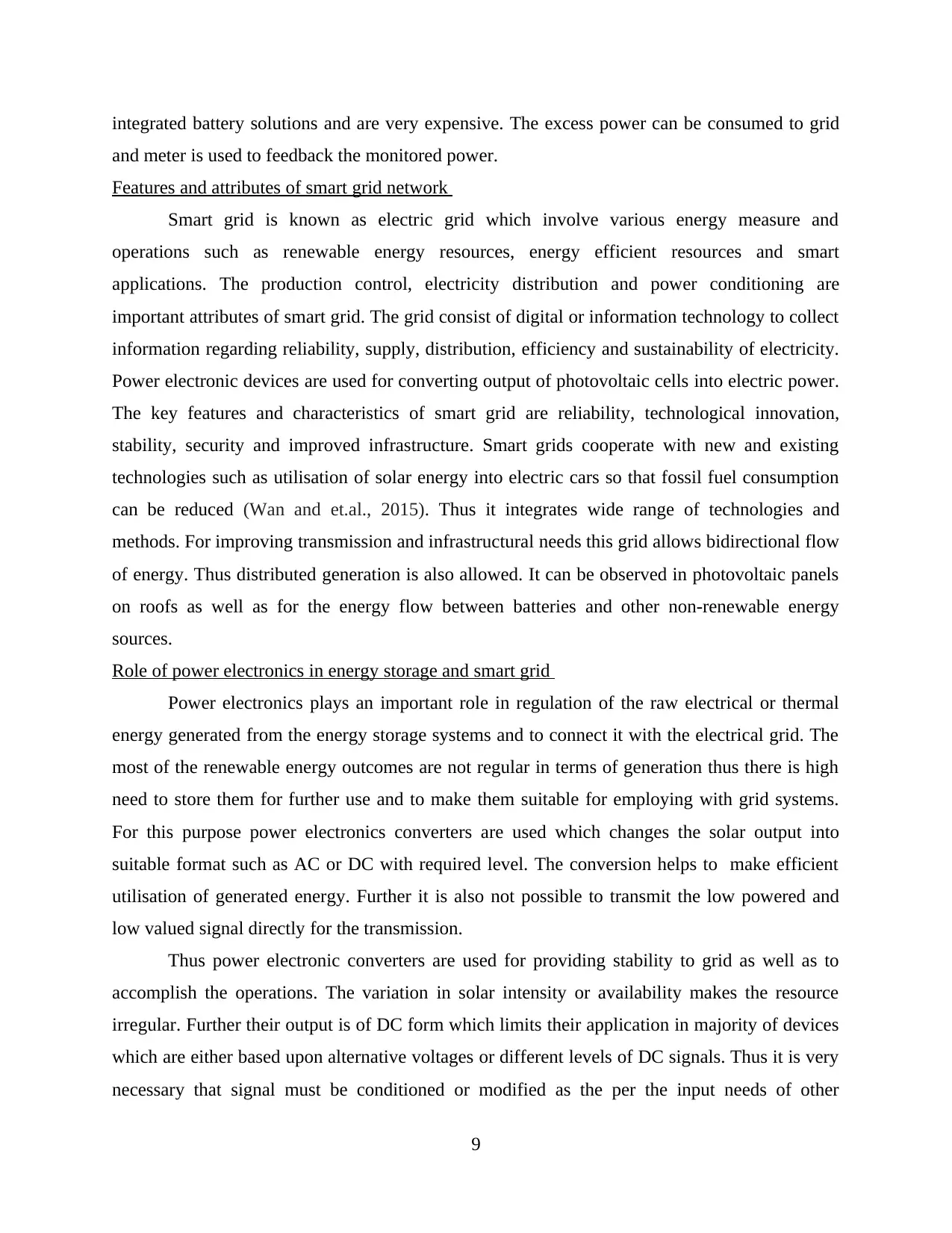
integrated battery solutions and are very expensive. The excess power can be consumed to grid
and meter is used to feedback the monitored power.
Features and attributes of smart grid network
Smart grid is known as electric grid which involve various energy measure and
operations such as renewable energy resources, energy efficient resources and smart
applications. The production control, electricity distribution and power conditioning are
important attributes of smart grid. The grid consist of digital or information technology to collect
information regarding reliability, supply, distribution, efficiency and sustainability of electricity.
Power electronic devices are used for converting output of photovoltaic cells into electric power.
The key features and characteristics of smart grid are reliability, technological innovation,
stability, security and improved infrastructure. Smart grids cooperate with new and existing
technologies such as utilisation of solar energy into electric cars so that fossil fuel consumption
can be reduced (Wan and et.al., 2015). Thus it integrates wide range of technologies and
methods. For improving transmission and infrastructural needs this grid allows bidirectional flow
of energy. Thus distributed generation is also allowed. It can be observed in photovoltaic panels
on roofs as well as for the energy flow between batteries and other non-renewable energy
sources.
Role of power electronics in energy storage and smart grid
Power electronics plays an important role in regulation of the raw electrical or thermal
energy generated from the energy storage systems and to connect it with the electrical grid. The
most of the renewable energy outcomes are not regular in terms of generation thus there is high
need to store them for further use and to make them suitable for employing with grid systems.
For this purpose power electronics converters are used which changes the solar output into
suitable format such as AC or DC with required level. The conversion helps to make efficient
utilisation of generated energy. Further it is also not possible to transmit the low powered and
low valued signal directly for the transmission.
Thus power electronic converters are used for providing stability to grid as well as to
accomplish the operations. The variation in solar intensity or availability makes the resource
irregular. Further their output is of DC form which limits their application in majority of devices
which are either based upon alternative voltages or different levels of DC signals. Thus it is very
necessary that signal must be conditioned or modified as the per the input needs of other
9
and meter is used to feedback the monitored power.
Features and attributes of smart grid network
Smart grid is known as electric grid which involve various energy measure and
operations such as renewable energy resources, energy efficient resources and smart
applications. The production control, electricity distribution and power conditioning are
important attributes of smart grid. The grid consist of digital or information technology to collect
information regarding reliability, supply, distribution, efficiency and sustainability of electricity.
Power electronic devices are used for converting output of photovoltaic cells into electric power.
The key features and characteristics of smart grid are reliability, technological innovation,
stability, security and improved infrastructure. Smart grids cooperate with new and existing
technologies such as utilisation of solar energy into electric cars so that fossil fuel consumption
can be reduced (Wan and et.al., 2015). Thus it integrates wide range of technologies and
methods. For improving transmission and infrastructural needs this grid allows bidirectional flow
of energy. Thus distributed generation is also allowed. It can be observed in photovoltaic panels
on roofs as well as for the energy flow between batteries and other non-renewable energy
sources.
Role of power electronics in energy storage and smart grid
Power electronics plays an important role in regulation of the raw electrical or thermal
energy generated from the energy storage systems and to connect it with the electrical grid. The
most of the renewable energy outcomes are not regular in terms of generation thus there is high
need to store them for further use and to make them suitable for employing with grid systems.
For this purpose power electronics converters are used which changes the solar output into
suitable format such as AC or DC with required level. The conversion helps to make efficient
utilisation of generated energy. Further it is also not possible to transmit the low powered and
low valued signal directly for the transmission.
Thus power electronic converters are used for providing stability to grid as well as to
accomplish the operations. The variation in solar intensity or availability makes the resource
irregular. Further their output is of DC form which limits their application in majority of devices
which are either based upon alternative voltages or different levels of DC signals. Thus it is very
necessary that signal must be conditioned or modified as the per the input needs of other
9
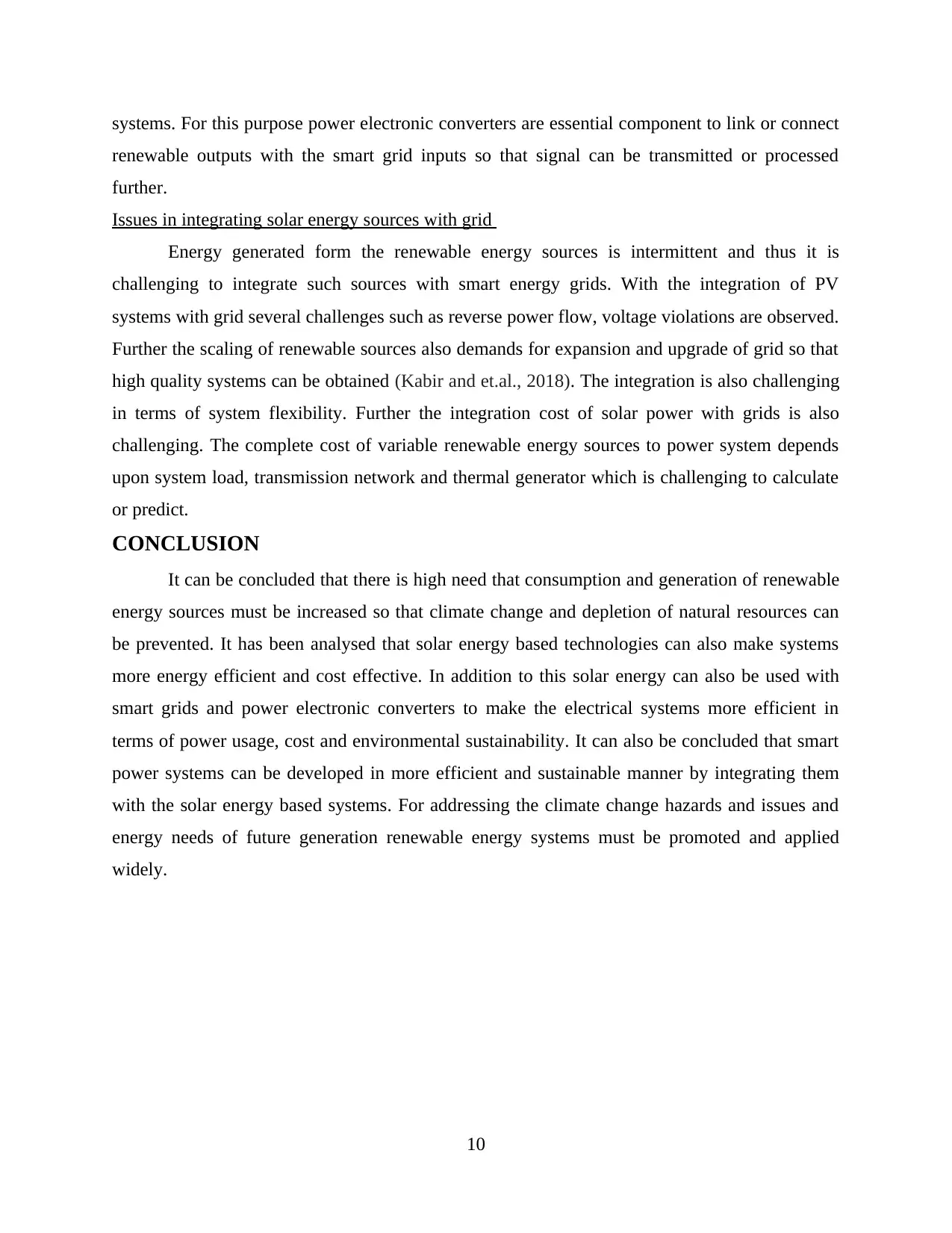
systems. For this purpose power electronic converters are essential component to link or connect
renewable outputs with the smart grid inputs so that signal can be transmitted or processed
further.
Issues in integrating solar energy sources with grid
Energy generated form the renewable energy sources is intermittent and thus it is
challenging to integrate such sources with smart energy grids. With the integration of PV
systems with grid several challenges such as reverse power flow, voltage violations are observed.
Further the scaling of renewable sources also demands for expansion and upgrade of grid so that
high quality systems can be obtained (Kabir and et.al., 2018). The integration is also challenging
in terms of system flexibility. Further the integration cost of solar power with grids is also
challenging. The complete cost of variable renewable energy sources to power system depends
upon system load, transmission network and thermal generator which is challenging to calculate
or predict.
CONCLUSION
It can be concluded that there is high need that consumption and generation of renewable
energy sources must be increased so that climate change and depletion of natural resources can
be prevented. It has been analysed that solar energy based technologies can also make systems
more energy efficient and cost effective. In addition to this solar energy can also be used with
smart grids and power electronic converters to make the electrical systems more efficient in
terms of power usage, cost and environmental sustainability. It can also be concluded that smart
power systems can be developed in more efficient and sustainable manner by integrating them
with the solar energy based systems. For addressing the climate change hazards and issues and
energy needs of future generation renewable energy systems must be promoted and applied
widely.
10
renewable outputs with the smart grid inputs so that signal can be transmitted or processed
further.
Issues in integrating solar energy sources with grid
Energy generated form the renewable energy sources is intermittent and thus it is
challenging to integrate such sources with smart energy grids. With the integration of PV
systems with grid several challenges such as reverse power flow, voltage violations are observed.
Further the scaling of renewable sources also demands for expansion and upgrade of grid so that
high quality systems can be obtained (Kabir and et.al., 2018). The integration is also challenging
in terms of system flexibility. Further the integration cost of solar power with grids is also
challenging. The complete cost of variable renewable energy sources to power system depends
upon system load, transmission network and thermal generator which is challenging to calculate
or predict.
CONCLUSION
It can be concluded that there is high need that consumption and generation of renewable
energy sources must be increased so that climate change and depletion of natural resources can
be prevented. It has been analysed that solar energy based technologies can also make systems
more energy efficient and cost effective. In addition to this solar energy can also be used with
smart grids and power electronic converters to make the electrical systems more efficient in
terms of power usage, cost and environmental sustainability. It can also be concluded that smart
power systems can be developed in more efficient and sustainable manner by integrating them
with the solar energy based systems. For addressing the climate change hazards and issues and
energy needs of future generation renewable energy systems must be promoted and applied
widely.
10
⊘ This is a preview!⊘
Do you want full access?
Subscribe today to unlock all pages.

Trusted by 1+ million students worldwide
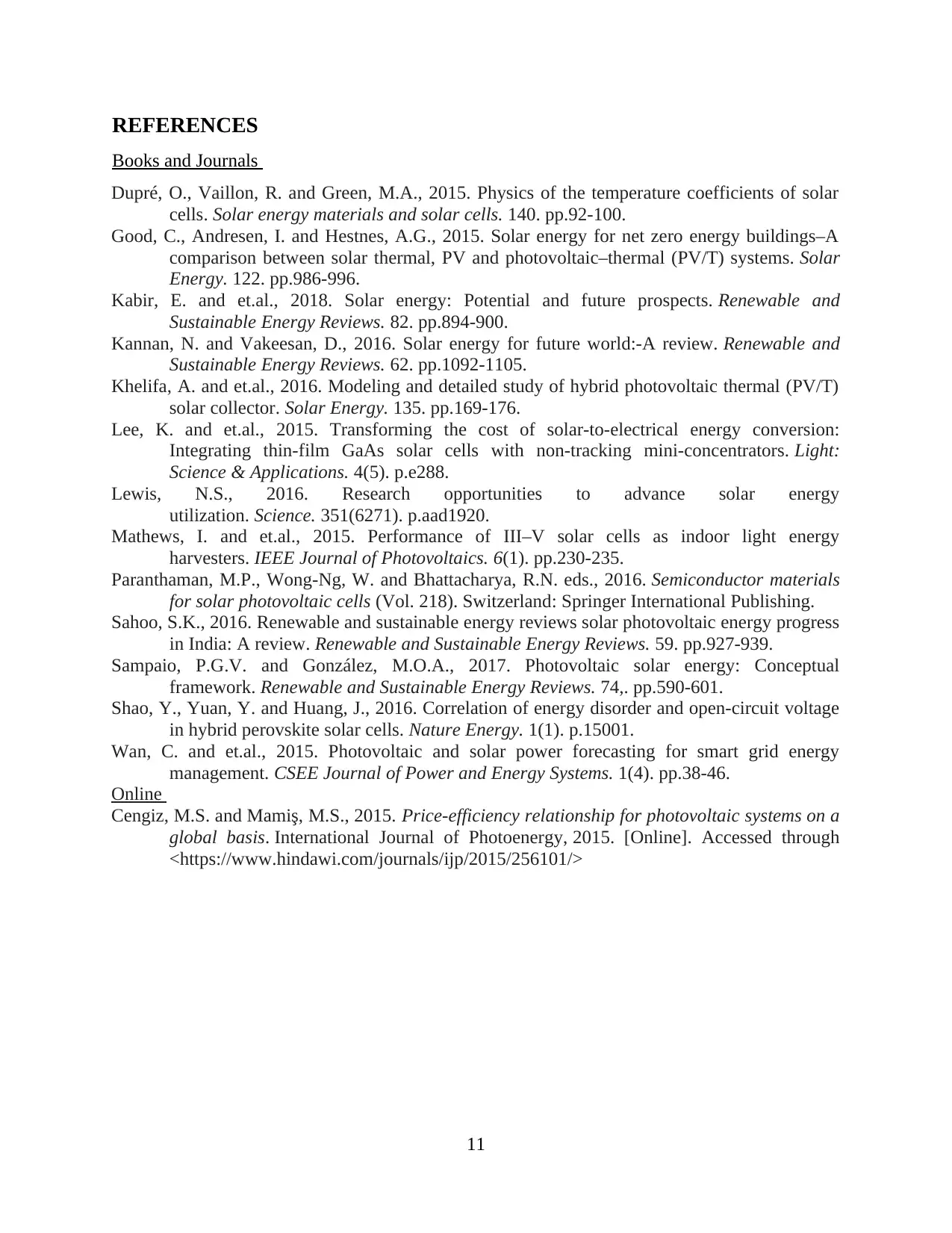
REFERENCES
Books and Journals
Dupré, O., Vaillon, R. and Green, M.A., 2015. Physics of the temperature coefficients of solar
cells. Solar energy materials and solar cells. 140. pp.92-100.
Good, C., Andresen, I. and Hestnes, A.G., 2015. Solar energy for net zero energy buildings–A
comparison between solar thermal, PV and photovoltaic–thermal (PV/T) systems. Solar
Energy. 122. pp.986-996.
Kabir, E. and et.al., 2018. Solar energy: Potential and future prospects. Renewable and
Sustainable Energy Reviews. 82. pp.894-900.
Kannan, N. and Vakeesan, D., 2016. Solar energy for future world:-A review. Renewable and
Sustainable Energy Reviews. 62. pp.1092-1105.
Khelifa, A. and et.al., 2016. Modeling and detailed study of hybrid photovoltaic thermal (PV/T)
solar collector. Solar Energy. 135. pp.169-176.
Lee, K. and et.al., 2015. Transforming the cost of solar-to-electrical energy conversion:
Integrating thin-film GaAs solar cells with non-tracking mini-concentrators. Light:
Science & Applications. 4(5). p.e288.
Lewis, N.S., 2016. Research opportunities to advance solar energy
utilization. Science. 351(6271). p.aad1920.
Mathews, I. and et.al., 2015. Performance of III–V solar cells as indoor light energy
harvesters. IEEE Journal of Photovoltaics. 6(1). pp.230-235.
Paranthaman, M.P., Wong-Ng, W. and Bhattacharya, R.N. eds., 2016. Semiconductor materials
for solar photovoltaic cells (Vol. 218). Switzerland: Springer International Publishing.
Sahoo, S.K., 2016. Renewable and sustainable energy reviews solar photovoltaic energy progress
in India: A review. Renewable and Sustainable Energy Reviews. 59. pp.927-939.
Sampaio, P.G.V. and González, M.O.A., 2017. Photovoltaic solar energy: Conceptual
framework. Renewable and Sustainable Energy Reviews. 74,. pp.590-601.
Shao, Y., Yuan, Y. and Huang, J., 2016. Correlation of energy disorder and open-circuit voltage
in hybrid perovskite solar cells. Nature Energy. 1(1). p.15001.
Wan, C. and et.al., 2015. Photovoltaic and solar power forecasting for smart grid energy
management. CSEE Journal of Power and Energy Systems. 1(4). pp.38-46.
Online
Cengiz, M.S. and Mamiş, M.S., 2015. Price-efficiency relationship for photovoltaic systems on a
global basis. International Journal of Photoenergy, 2015. [Online]. Accessed through
<https://www.hindawi.com/journals/ijp/2015/256101/>
11
Books and Journals
Dupré, O., Vaillon, R. and Green, M.A., 2015. Physics of the temperature coefficients of solar
cells. Solar energy materials and solar cells. 140. pp.92-100.
Good, C., Andresen, I. and Hestnes, A.G., 2015. Solar energy for net zero energy buildings–A
comparison between solar thermal, PV and photovoltaic–thermal (PV/T) systems. Solar
Energy. 122. pp.986-996.
Kabir, E. and et.al., 2018. Solar energy: Potential and future prospects. Renewable and
Sustainable Energy Reviews. 82. pp.894-900.
Kannan, N. and Vakeesan, D., 2016. Solar energy for future world:-A review. Renewable and
Sustainable Energy Reviews. 62. pp.1092-1105.
Khelifa, A. and et.al., 2016. Modeling and detailed study of hybrid photovoltaic thermal (PV/T)
solar collector. Solar Energy. 135. pp.169-176.
Lee, K. and et.al., 2015. Transforming the cost of solar-to-electrical energy conversion:
Integrating thin-film GaAs solar cells with non-tracking mini-concentrators. Light:
Science & Applications. 4(5). p.e288.
Lewis, N.S., 2016. Research opportunities to advance solar energy
utilization. Science. 351(6271). p.aad1920.
Mathews, I. and et.al., 2015. Performance of III–V solar cells as indoor light energy
harvesters. IEEE Journal of Photovoltaics. 6(1). pp.230-235.
Paranthaman, M.P., Wong-Ng, W. and Bhattacharya, R.N. eds., 2016. Semiconductor materials
for solar photovoltaic cells (Vol. 218). Switzerland: Springer International Publishing.
Sahoo, S.K., 2016. Renewable and sustainable energy reviews solar photovoltaic energy progress
in India: A review. Renewable and Sustainable Energy Reviews. 59. pp.927-939.
Sampaio, P.G.V. and González, M.O.A., 2017. Photovoltaic solar energy: Conceptual
framework. Renewable and Sustainable Energy Reviews. 74,. pp.590-601.
Shao, Y., Yuan, Y. and Huang, J., 2016. Correlation of energy disorder and open-circuit voltage
in hybrid perovskite solar cells. Nature Energy. 1(1). p.15001.
Wan, C. and et.al., 2015. Photovoltaic and solar power forecasting for smart grid energy
management. CSEE Journal of Power and Energy Systems. 1(4). pp.38-46.
Online
Cengiz, M.S. and Mamiş, M.S., 2015. Price-efficiency relationship for photovoltaic systems on a
global basis. International Journal of Photoenergy, 2015. [Online]. Accessed through
<https://www.hindawi.com/journals/ijp/2015/256101/>
11
1 out of 13
Related Documents
Your All-in-One AI-Powered Toolkit for Academic Success.
+13062052269
info@desklib.com
Available 24*7 on WhatsApp / Email
![[object Object]](/_next/static/media/star-bottom.7253800d.svg)
Unlock your academic potential
© 2024 | Zucol Services PVT LTD | All rights reserved.





